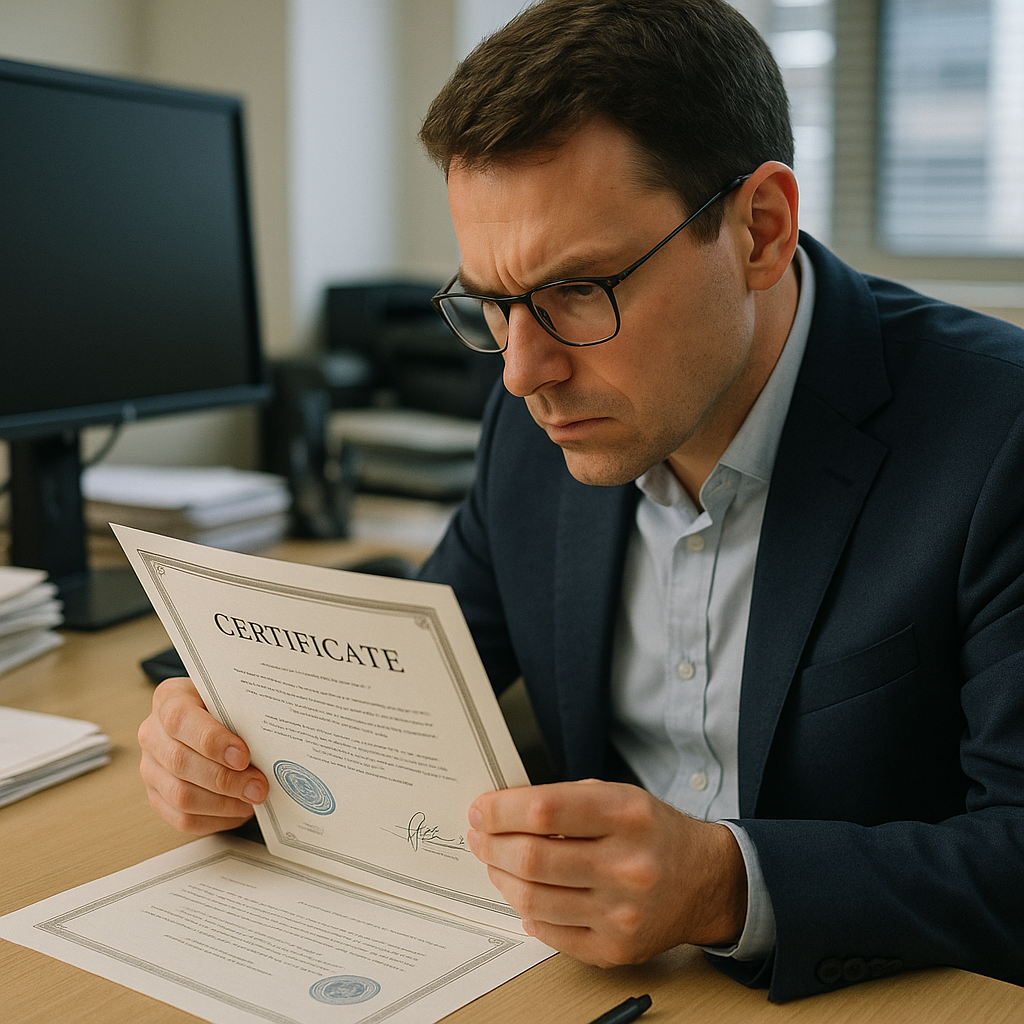5901 Botham Jean Blvd, Dallas, TX 75215
What is a Certificate of Destruction for Electronics?
July 19, 2025A Certificate of Destruction for electronics is an official document that verifies sensitive data and electronic devices have been securely destroyed. This essential document serves as legal proof that your organization has properly disposed of confidential information stored on electronic media. When electronic devices reach the end of their lifecycle, this certificate confirms all data they contained is permanently unrecoverable.
Proper disposal of electronic equipment isn’t just a prudent practice—it’s often required by law. Organizations handling sensitive customer information, proprietary data, or regulated information must demonstrate compliance with various data privacy regulations, such as HIPAA, GLBA, and FACTA. The certificate provides documented evidence of this compliance.
Typically issued by certified electronics recyclers or specialized data destruction service providers, a Certificate of Destruction includes critical details such as the date of destruction, method used, serial numbers of devices processed, and verification signatures. This documentation creates an auditable trail that protects organizations during regulatory inspections or in the event of a data breach investigation.
What Information is Included in a Certificate of Destruction?

A Certificate of Destruction serves as an official record to document that your sensitive materials have been properly destroyed. This crucial document includes specific information that validates the destruction process and creates an audit trail for compliance purposes. The certificate typically contains several key components that establish a proper chain of custody.
Understanding what should appear on your Certificate of Destruction helps ensure you receive proper documentation for your records. Organizations handling confidential information must maintain these certificates as evidence of compliance with data protection regulations and industry standards.
Essential Components of a Certificate of Destruction
A properly formatted Certificate of Destruction contains the following key elements:
- Client Information: The full legal name and address of your organization, establishing who requested the destruction service.
- Service Provider Details: The name, address, and contact information of the company that performed the destruction service.
- Date and Time: When the destruction service took place, providing a timestamp for the record.
- Destruction Method: The specific technique used to destroy the materials, such as cross-cut shredding, pulverizing, or incineration.
- Material Identification: A description of the destroyed items, including types of documents, media, or other elements.
- Quantity Information: The volume or quantity of material destroyed, often measured in pounds, boxes, or number of devices.
- Certification Statement: A formal declaration confirming that the listed items were completely and securely destroyed.
- Manifest Numbers: Reference numbers linking to transportation or processing records for tracking purposes.
- Authorized Signatures: Signatures from personnel who witnessed or were responsible for the destruction process.
- Company Logo/Letterhead: Official branding from the service provider, adding legitimacy to the document.
These details create a comprehensive record serving multiple purposes in your information management program. The certificate is particularly valuable during audits or when demonstrating regulatory compliance.
The Legal and Compliance Value
Beyond simply listing what was destroyed, a Certificate of Destruction transfers responsibility from your organization to the service provider. This transfer of liability offers significant protection should questions arise about handling sensitive information. The certificate completes the documented chain of custody for your materials and serves as written proof of your compliance with relevant data protection laws.
For industries subject to specific regulations like HIPAA, FACTA, or GDPR, these certificates are essential components of a comprehensive information security program. They demonstrate your diligence in properly disposing of confidential information throughout its lifecycle.
| Client Information | The full legal name and address of the organization requesting the destruction service. |
| Service Provider Details | The name, address, and contact information of the company providing the destruction service. |
| Date and Time | When the destruction service was completed. |
| Destruction Method | The specific method used to destroy the materials (e.g., shredding, incineration). |
| Material Identification | A description of the destroyed materials, such as document types or electronic media. |
| Quantity Information | The volume or amount of material destroyed. |
| Certification Statement | A declaration confirming the materials were completely and securely destroyed. |
| Manifest Numbers | Reference numbers related to transportation or processing records for tracking. |
| Authorized Signatures | Signatures from responsible persons who witnessed or verified the destruction process. |
| Company Logo/Letterhead | Official branding of the service provider for document authenticity. |
When evaluating a Certificate of Destruction, ensure all these elements are present and clearly documented. A missing component could weaken the certificate’s value as evidence of proper destruction. Organizations should retain these certificates per their document retention policies, making them available for audits and compliance verification.
The certificate’s thoroughness reflects the service provider’s professionalism and commitment to security standards. Reputable destruction services understand the importance of detailed documentation in maintaining an unbroken chain of custody from collection to final destruction.
Why is a Certificate of Destruction Important?

A Certificate of Destruction is crucial documentation in today’s data-sensitive business environment. It provides formal proof that confidential information has been permanently and securely destroyed, offering organizations concrete evidence of proper disposal protocols.
Regulatory compliance is a primary benefit. With data privacy laws like GDPR, HIPAA, and CCPA imposing strict requirements, a Certificate of Destruction demonstrates adherence to regulations. During audits or legal proceedings, it verifies data was destroyed using approved methods that meet industry standards.
Liability protection is another significant advantage. When an organization receives a Certificate of Destruction, responsibility for secure disposal shifts from the business to the certificate issuer. This transfer helps protect organizations from potential lawsuits or penalties arising from improper data disposal. The certificate creates a clear audit trail showing what information was destroyed, when, where, and by whom.
Certificates of Destruction also provide peace of mind to stakeholders. Organizations can assure clients, partners, and employees that their sensitive information has been properly handled, building trust and demonstrating a commitment to data security practices. For example, healthcare organizations managing patient records can use these certificates as evidence of their commitment to protecting private information.
For industries handling sensitive data, such as healthcare, finance, and government sectors, Certificates of Destruction are essential. These sectors face heightened scrutiny and steeper penalties for data breaches. Financial institutions, for instance, rely on these certificates to prove secure disposal of customer financial records after retention periods expire.
In a data breach investigation, a comprehensive Certificate of Destruction can serve as vital evidence that specific information was properly eliminated from systems. This documentation demonstrates due diligence, potentially reducing fines or sanctions from regulatory bodies.
The value of these certificates increases with the data’s sensitivity. When destroying documents or devices containing personally identifiable information, intellectual property, or classified data, proper certification becomes a critical component of a comprehensive information security strategy.
| Key Element | Purpose |
|---|---|
| Client Information | Identifies the organization that requested the destruction service |
| Service Provider Details | Provides the name, address, and contact information of the destruction company |
| Date and Time | Records when the destruction took place |
| Destruction Method | Specifies the technique used, such as shredding or incineration |
| Material Identification | Describes what materials were destroyed, like documents or devices |
| Quantity Information | Details the amount of material destroyed, often in pounds or devices |
| Certification Statement | Declares that items were securely destroyed |
| Manifest Numbers | Links to transportation or processing records |
| Authorized Signatures | From personnel responsible for the destruction process |
| Company Logo/Letterhead | Adds legitimacy to the document |
How to Ensure Your Certificate of Destruction is Valid

A Certificate of Destruction provides proof that sensitive data has been properly eliminated from retired electronic devices. However, not all certificates carry the same weight or legal status. It’s essential to verify the validity of these certificates to ensure your organization remains compliant and secure.
Work with Certified Recycling Partners
The validity of a certificate begins with choosing the right electronics recycler. Work only with companies that have recognized industry certifications, indicating adherence to strict standards for data security and environmental responsibility.
Seek providers with the following key certifications:
- NAID AAA Certification – The National Association for Information Destruction’s highest certification verifies adherence to stringent data destruction protocols.
- R2 Certification – Responsible Recycling certification ensures proper environmental and data security practices.
- e-Stewards Certification – Guarantees responsible handling of electronic waste without exporting it to developing countries.
Verify Certificate Contents
A legitimate Certificate of Destruction should contain specific information validating the service performed. Ensure the certificate includes:
- Your organization’s name and address
- Date of service completion
- Detailed inventory of destroyed items (including serial numbers when applicable)
- Method of destruction used
- Statement confirming destruction according to relevant standards (such as NIST 800-88)
- The recycler’s certification numbers and credentials
- Authorized signature from the service provider
Without these elements, the certificate may not meet regulatory requirements during an audit or investigation.
Understand Certificate Limitations
A Certificate of Destruction is crucial, yet it does not fully ensure regulatory compliance. Its reliability depends on the issuing company. Documents from uncertified or untrustworthy companies offer little protection against possible data breaches or regulatory infractions.
The certificate is only one part of your data security strategy. It documents the final step in disposing of assets but doesn’t replace proper vendor selection or ongoing due diligence.
| Key Element | Valid Certificate | Invalid Certificate |
|---|---|---|
| Client Information | Includes full legal name and address | Incomplete or missing details |
| Service Provider Details | Includes name, address, and contact info | Incomplete or generic information |
| Date and Time | Specific date and time included | Missing or vague date |
| Destruction Method | Specifically documented method, e.g., shredding | Unspecified method |
| Material Identification | Detailed description of destroyed items | Vague or missing description |
| Quantity Information | Detailed volume or number of items | No clear indication of quantity |
| Certification Statement | Formal declaration of complete destruction | Absent or incomplete declaration |
| Manifest Numbers | Reference numbers included | Missing manifest numbers |
| Authorized Signatures | Includes signatures from responsible personnel | Missing or unclear signatures |
| Company Logo/Letterhead | Official branding present | Absent or inconsistent branding |
Conduct Proper Vendor Due Diligence
Before entrusting a recycler with your sensitive equipment, conduct thorough due diligence:
- Request and verify current copies of all certifications
- Ask about their specific destruction methods and security protocols
- Inquire about downstream vendors they work with
- Check for insurance coverage protecting against data breaches
- Request references from similar organizations in your industry
- Consider on-site witnessing of the destruction process for highly sensitive assets
Organizations in regulated industries like healthcare or finance should be particularly stringent in their vendor evaluation process. Improper data handling can result in substantial financial penalties and reputational damage.
By selecting certified recycling partners carefully and verifying the contents of your Certificates of Destruction, you establish a defensible data security position. This attention to detail shields your organization from the risks of improper data disposal and ensures compliance with relevant regulations.
Conclusion: Safeguarding Your Data with Proper Documentation

A Certificate of Destruction for electronics is vital in modern data security frameworks. Throughout this article, we’ve discussed how these certificates serve as legal proof that sensitive data has been destroyed in line with industry standards and regulations. Organizations that prioritize obtaining this documentation demonstrate due diligence in protecting confidential information and complying with laws like GDPR, HIPAA, and GLBA.
By insisting on a Certificate of Destruction when disposing of electronic devices, organizations create an auditable trail validating their commitment to data security. This documentation reassures stakeholders, mitigates legal liability, and provides tangible evidence during audits or investigations. Amid increasing data breaches and regulatory scrutiny, proper documentation isn’t just good practice—it’s essential for managing organizational risk.
For electronic recycling and data destruction services that prioritize security and compliance, contact Okon Recycling at 214-717-4083. Our team of experts can help safeguard your sensitive information while ensuring the environmentally responsible disposal of your electronic assets.
